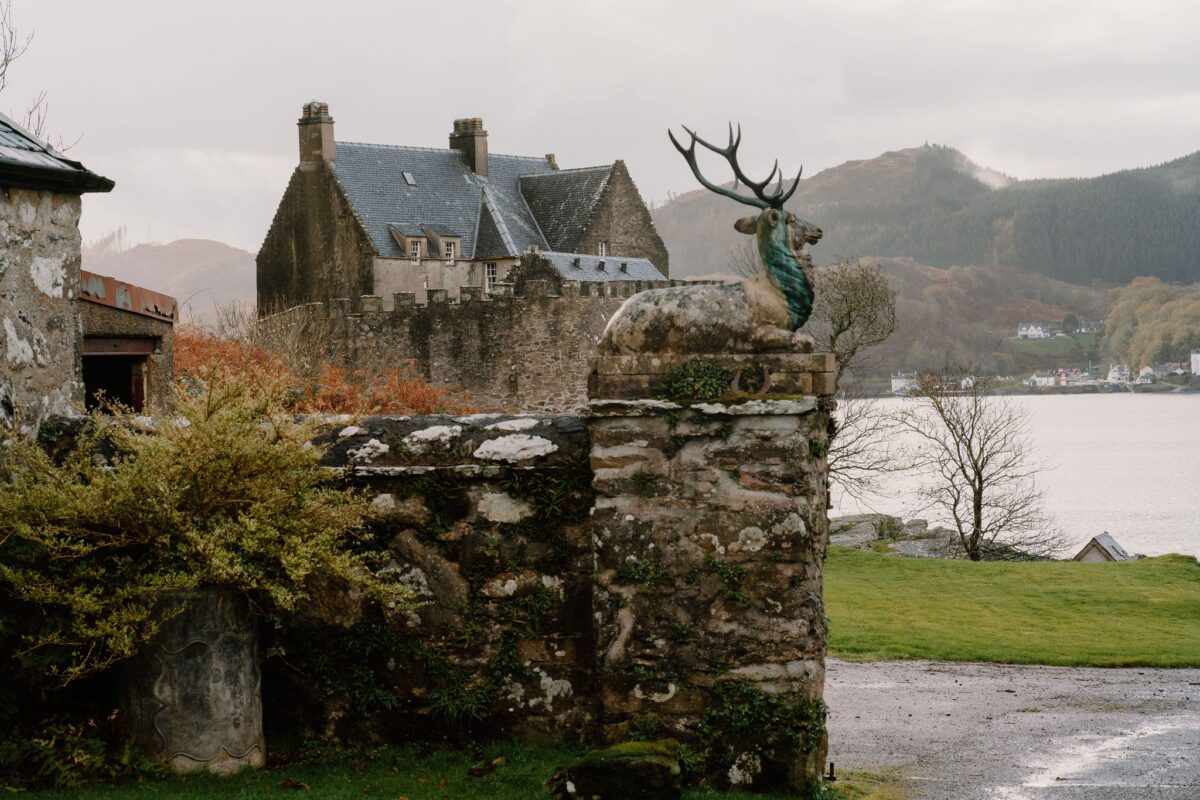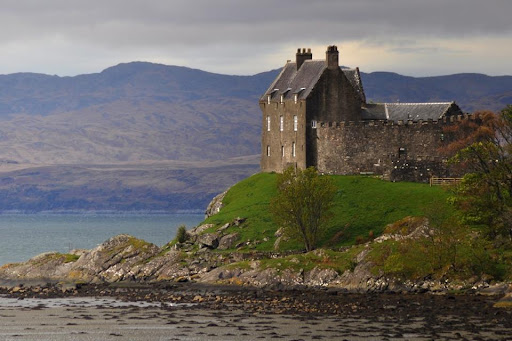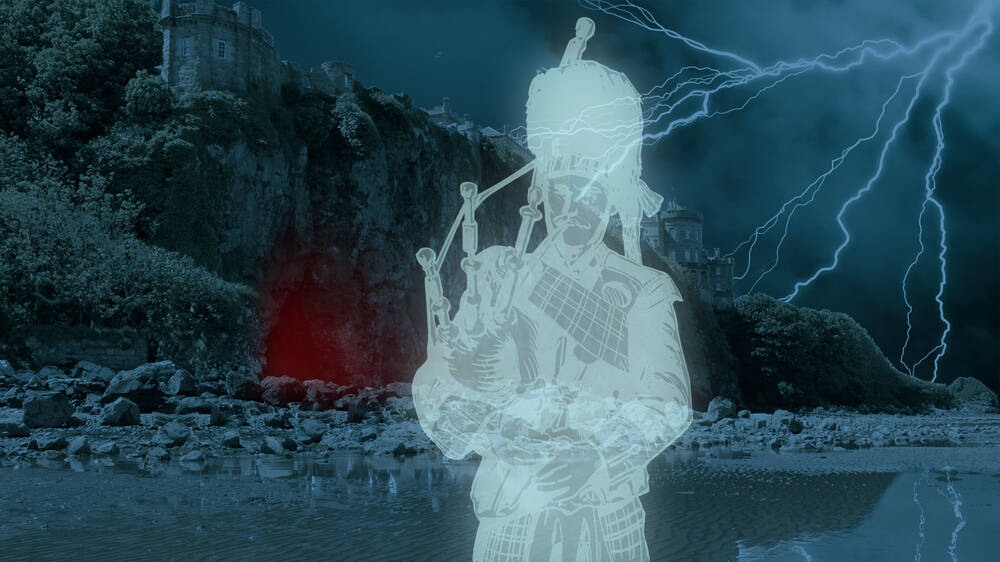The Lost Piper A Haunting Melody from Duntrune

In the rugged, haunting beauty of Scotland’s western Highlands, nestled along the northern banks of Loch Crinan, stands the ancient and stately Duntrune Castle. A relic of Scotland’s tumultuous past, this seemingly serene structure, dating back to the 12th century, has stood sentinel over the shifting tides of history, through wars, betrayals, and bitter clan rivalries. As the wind sweeps across the loch, it carries with it more than just the salt spray of the sea; it is said to carry the echoes of a haunting melody, the ghostly strains of a bagpipe that once played a desperate warning.
The story of Duntrune Castle is interwoven with the bloody history of Scotland’s wars, particularly during the 17th century when the country was torn asunder by civil conflict. It was a time when the Highlands were a cauldron of bitter feuds, old enmities, and fierce loyalties, and the harsh landscape mirrored the hearts of the men who fought to defend their homes, their clans, and their beliefs. The wars of King Charles I against his Parliament, which culminated in his eventual execution in 1649, were not confined to England alone. They spilled into the Highlands, dragging the clans into a conflict that was as much about religion and power as it was about survival.
The tale that has given Duntrune Castle its spectral legacy is one rooted in these dark and violent times. The feud between the MacDonalds and the Campbells was one of the most infamous in Scottish history, and while its origins are shrouded in the mists of time, it was certainly exacerbated during the Wars of the Three Kingdoms. On one side of this ancient feud stood the MacDonalds, proud and fierce, and on the other, the Campbells, equally determined and ruthless. These two clans had been at odds for centuries, and their rivalry was brought to a head during the civil war, when each clan found itself on opposing sides.
At the heart of our tale is the MacDonald chieftain, a formidable warrior named Alasdair Mac Colla, known more famously as Colkitto. A giant of a man, Colkitto was a skilled tactician and a master of guerrilla warfare. He was renowned not only for his ferocity in battle but also for his unyielding loyalty to his clan. During the civil war, Colkitto aligned himself with the Royalists, fighting in support of King Charles and against the Parliamentarians. His clan, the MacDonalds, had long been enemies of the Campbells, who sided with the Covenanters, the faction that supported Parliament. The enmity between these two clans was more than just political; it was personal, rooted in a complex web of land disputes, betrayals, and long-held grudges.
The story begins on a cold, windswept night in the mid-1600s, when Colkitto and his band of MacDonald warriors descended upon Duntrune Castle. The Campbells held the castle at that time, but in the darkness and confusion, the MacDonalds were able to take control of the fortress, seizing it as a strategic stronghold in their ongoing war. Colkitto, ever the strategist, left behind a small garrison of his men to hold the castle while he continued on his campaign across the Sound of Jura, leaving Duntrune in the hands of his trusted soldiers. Among those left behind was a man of great significance: the MacIntyre piper.
The piper, whose name has been lost to history, was no ordinary musician. He had been gifted to Colkitto by the MacIntyre clan as a token of gratitude for Colkitto’s assistance in their own battles. The piper’s role was not merely to entertain; in Highland culture, the piper was a figure of great importance, often serving as a spiritual and emotional guide, his music a powerful force that could rally warriors or mourn the dead. This particular piper was known for his skill in playing the haunting and evocative music of the Highlands, a talent that would soon seal his fate.
As the days passed, the Campbells regrouped and launched a counter-attack to reclaim Duntrune. In the ensuing battle, all of the MacDonald warriors were killed—save for the piper, who was spared by the Campbells. His life was spared not out of mercy, but because the Campbells, cruel and calculating, wanted him to play for them. It was a twisted gesture, forcing him to provide the music that would celebrate their victory over his own people.
But the piper had other plans. As he was forced to play for the Campbells, he bided his time, waiting for the moment when he could warn his master, Colkitto, of the danger that awaited him. That moment came when Colkitto’s boat was spotted on the waters of the Sound of Jura, approaching the castle, unaware of the deadly trap that lay in wait.
With great care, the piper began to play a tune he had composed in honour of Colkitto’s return. The music drifted out across the still waters of the loch, carried by the wind to the ears of the MacDonald chieftain. But this was no ordinary tune. The piper, knowing that the Campbells would be listening, deliberately altered certain notes, creating a subtle but unmistakable warning within the melody. The tune he played was known as "Piobaireachd-dhum-Naomhaid," or "The Piper’s Warning to His Master."
Colkitto, a man attuned to the rhythms and nuances of Highland music, recognized the warning. The strange dissonance in the melody told him that something was wrong. He immediately ordered his boat to turn around, steering away from Duntrune and the ambush that awaited him. His quick thinking saved his life and the lives of his men, but the piper’s act of defiance did not go unnoticed.
The Campbells, furious at being outwitted, exacted a brutal punishment on the piper. In a fit of rage, they seized him and cut off his hands, ensuring that he would never play the pipes again. It is said that the piper bled to death from his injuries, his lifeblood staining the stones of Duntrune Castle. The castle that had once echoed with the sound of his music now bore witness to his silent agony.
But death was not the end for the piper. For centuries after, strange occurrences have been reported at Duntrune Castle. Visitors and residents alike have spoken of hearing the eerie sound of bagpipes playing in the dead of night, the notes drifting through the air as if carried on the wind from across the loch. Others have reported seeing objects move on their own, or hearing strange banging noises echoing through the halls. It is said that the spirit of the piper still haunts the castle, bound to the place where he met his tragic end.
For many years, the story of the piper was thought to be just that—a story. But in the late 1800s, during a renovation project at Duntrune, workers made a chilling discovery. Beneath the castle, they unearthed the skeletal remains of a man. His body was mostly intact—his skull, arms, legs, and torso were all present—but his hands were missing. The bones were reburied outside the castle in an unmarked grave, a quiet resting place for a man whose music once filled the air.
But that was not the only discovery. In a later excavation, workers uncovered a pair of skeletal hands, buried under one of the castle’s rooms. The hands, long separated from the body to which they belonged, were a grim reminder of the piper’s fate, and of the dark history that still clings to Duntrune Castle like a shadow.
The ghostly legacy of the piper is just one chapter in the long and bloody history of the Highlands. The wars that tore Scotland apart in the 17th century were as much about religion and power as they were about the ancient clan rivalries that had simmered for centuries. The Covenanters, with their roots in Presbyterianism, sought to reform the church and oppose the king, while the Royalists, including clans like the MacDonalds, remained loyal to the crown. In the Highlands, where loyalty to one’s clan often outweighed loyalty to the crown or church, the conflict became deeply personal.
The feud between the Campbells and the MacDonalds was one of the fiercest in Scotland’s history, and it was not confined to the battlefield. It was a feud that played out in everyday life, in the lands that the clans fought over, and in the hearts of the men and women who carried the weight of generations of conflict. Even today, in some parts of Scotland, the name "Campbell" is met with suspicion and hostility, a lingering remnant of a rivalry that has never truly faded.
Duntrune Castle, with its ancient stones and its haunting history, stands as a testament to that legacy. It is a place where the past is never far away, where the wind seems to whisper the names of those who fought and died for their clans, and where the sound of bagpipes can still be heard, played by a ghost who sacrificed everything to warn his master.
The Highlands of Scotland are a place of wild beauty and untamed spirits, a land where the mountains rise like jagged teeth and the lochs stretch out like dark mirrors, reflecting a sky that is often stormy and brooding. It is a landscape that has shaped the people who live there, and the stories that have emerged from the Highlands are as rugged and haunting as the land itself.
In the end, the story of the piper of Duntrune is more than just a ghost story. It is a reminder of the cost of loyalty, of the bonds that tie men to their clans and their land, and of the haunting echoes of history that can never be fully silenced. As long as Duntrune Castle stands, and as long as the wind sweeps across the loch, the piper’s warning will be heard, a spectral melody that lingers in the air, a reminder of a time when the clash of swords and the wail of bagpipes were the soundtrack to life and death in the Highlands of Scotland.
You can listen to the full podcast for more tales from Scotland here:
https://www.podpage.com/haunted-history-chronicles/spectral-stories-of-scotland-with-wayne-gilbert/
Copy to Wayne’s book: https://www.amazon.co.uk/Hidden-Haunts-Scotland-W-J-Gilbert/dp/1954528868
Link to the Eerie Edinburgh YouTube page: https://www.youtube.com/channel/UCV6a7AFyWPTub03B6A98KAA






















